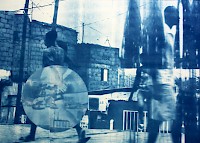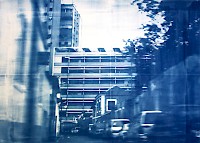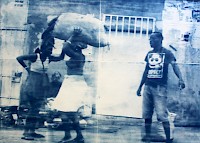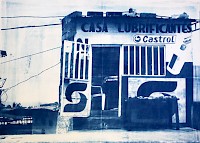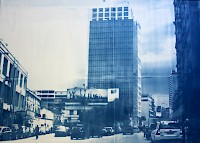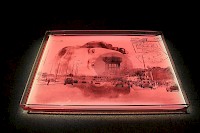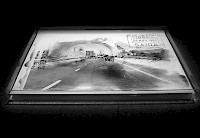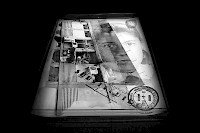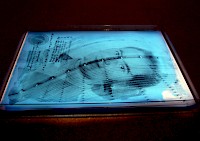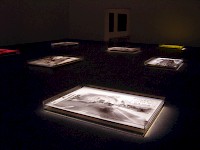ANAESTHESIA AND THE CONSTRUCTION OF VISUALITY IN DELIO JASSE'S PHOTOGRAPHY
'Attention implies the possibility of a fixation, of holding something in wonder or
contemplation, in which the attentive subject is both immobile and
ungrounded. But at the same time a suspension is also a cancellation or an
interruption, and I wanted here to indicate a disturbance, even a
negation of perception itself. (...) Perception can be both an absorbtion and an absence or deferral'1
Marta Jecu: When I look at your work, I see people, architecture, and landscape framed cinematically, without any psychological, aesthetic, or ethnographic imposition. They transmit a melancholic and diffuse acknowledgment of history.
Contrary to ethnographic photography, but also to journalistic photography, where the gaze searches for untried experiences, the spectacular and 'the new' to feed curiosity, in your juxtaposition of images, a slow continuous time and space unifies the visual field. It emanates from a type of inclusive perception, in which the travelling eye knows his unfulfillable condition. There is always something missing, and the searched-for places can actually never be reached. The situations which we see in your images and their protagonists are not representative and are not classified, attributed or typified.
I was thinking that they look like simultaneous being inside and absenting from the various places they inhabit. They express a particular way to see the world : they seem to be in a state of reverie or a sort of separation and resistance to a dominating reality.
From our discussions before the key theme of 'absence' stands out, which you relate to various forms of disturbance regarding the Angolan reality. When you talk about social aspects of your culture, it seems that you programmatically avoid a pre-formulated post-colonial register of ideas. The same could be said about your images, that stimulate critical attention for what is dimly perceived. Your images reorient attention towards what stays at the periphery of the dominant discourse. In these faded and abstracted layers of visuality where attention seems to lack, we are met by the blind spot of the visual field.
As a result, I wonder if the title of your work 'Ausencia Permanente' (2014) refers to concrete situations in your images or if it describes a larger metaphorical context?
Délio Jasse: The title signifies a relationship rather than a matter of fact: specificaly the space of mutual projections between Angola and Portugal. After creating this series of images, I realized that they were showing a perpetual absence. Absence does not have to do with the lack of action or with a feeling that nothing has happened. Rather, it refers to the fact that although despite being one of the top ten oil economies, there remains a lack of visibility and clarity in how Angola perceives itself and how it is perceived from outside. After 1975, when the Portuguese colonial powers retreated, Angola shifted from a site of administration into one of investment resources. This ‘come-back’ didn’t efface or reverse the historic memory, but it added a new layer, without the necessary reparations or restorations. Therefore, absence comes to refer to a lack of consciousness in the politic, economic, and diplomatic relationships between these two countries.
This tension is very dynamic visible in my images—the colonial Portuguese buildings and streets built in 1950s Angola, the portraits of Portuguese colonists registered in travel documents— they all seem in a way dematerialized, lost in the course of time. There is not much left from these people, faces and presences, from their history, than a few symbols, numbers, stamps. This loss of meaning on which history cannot be re-built and repaired, only maintains and re-affirms an irreconcilable distance, a difference. Besides the common language between Portugal and Angola, there is no constructive and solid structure left from the past that we can built upon. This permanent absence is installed between the two poles Portugal and Angola. It exists also in the reciprocal interpretations of each other. There is always something missing, something misunderstood. There is an absence in the answers to my questions regarding what has happened historically between these two cultures, as if coherence is lacking.
Absence manifests not only in Luanda but also in the province, which is under-developed and overpopulated. Angola has been port to many flows of migration: Americans, Cubans, now Chinese. There is nothing concrete left from all of these exchanges. There is no coherence or something on which we can start building. After the fall of the Portuguese colonial empire, nothing has been put in place— save for some skyscrapers, connected to corrupted economic relations. We haven't yet built a new identity, new cities which function in a structured way, beyond the speed that is now dominating the city. We are left with nothing, and this is the absence that I am referring to here. I am working with this absence in my images.
M.J.: In thinking further about this idea of absence that you analyze in your work, I find Jonathan Crary's idea of counter-attention very inspiring. It actually represents the subject's resistance to reality with its forces and relations of power2. He recalls that since the beginning of the 20th century it is no longer a question of how an already constituted subject knows and perceives the objectivity of an external world, but how a subject is provisionally constructed through systems of social meaning and value.3
Jonathan Crary's concept of anaesthesia of the visible can also offer a clue. As a consequence of the concentration of attention of the whole mind on a single point, an intensification of perception on this point is producing around it a zone of anaesthesia4. Crary's theory demonstrates that anaesthesia (the absence of coherence in Angola's reality that you talk about and which you shows in your work) is not only a decreasing of sensations and attention, but transports proportionally the intensification of resistance and consciousness on some focal issues. What I appreciate most in your work is that you transmit this resistance without recurring to the common tools of formulas of national and cultural 'tradition'.
You are rather talking about an absence of oneself, of contact with oneself and this in relation to a whole culture.
D.J.: Yes exactly, It is a loss of characteristics, and this is due to a continuous change, the change does not stop, there is no permanency. If you go to Portugal, you will find a Portugal which is equal to what you have encountered 20, 30, 40 years ago.
M.J.: which is also extreme!
D.J.: In Angola the past is constantly effaced, eliminated, the old is demolished in order to built something new, which is again covered by a newer structure in a continuous process that prevents the possibility to built a coherent identity in time. It is like we are always building a simulacrum of identity, a copy.
M.J.: I see the idea of 'permanent absence' as emblematic for your entire work, since in your prints and photos reality is always hidden behind a layer – a color, a filter, or an abstraction of the depicted image. Reality passes into a second level, it becomes inaccessible. There is this paradox of making visible that which is lacking.
D.J.: Yes, reality seems to be unreal in my work, which comes mainly from the superposition of images—which refers to a changing society with a mix of references, with fragmentary initiatives and movements. I use color to fill in and mark this absence, this void. I am also reflecting on a lack of balance that I experience, in which it is difficult to orient myself.
M.J.: For me, these layers that you construct also have a very strong temporal dimension, in the sense that we contemplate a moment in time, but we are never sure if we are placed in the past, the future, or a present that looks back to other historic moments.
D.J.: This temporal quality of the image is also due to the analogue process of constructing the image, which is developing in time. Accidents that take place in the dark room and affect the image, are recorded and projected onto the future image. I exhibit these works in water, as a way to refer all these layers and transformations they went through, and which correspond to a subject that records a temporality beyond a single photographic shot. The boxes with water in which I exhibit the image are open, so impurities fall inside and add another layer of information from these various contexts. In Angola we often joke about the fact that we do not produce anything. From objects, clothes, technical equipment, everything that we have in Angola comes from outside. It is the same garbage from the US or China. The fact that even our garbage doesn’t have its own identity, is another form of absence.
M.J.: This absence is manifested also in these portraits of anonymous people, that we have no reference about. Nevertheless, the titles of your two works are actually marking an opposition: Ausensica Permanente 'permanent absence' and Terreno Ocupado (2014 ) 'occupied territory'. What does this opposition signify for you?
D.J.: 'Terreno Occupado' (a panel of 24 works) was shown in Lisbon shortly after 'Ausencia Permanente' in Museu Coleçao Berardo (as part of the BES prize exhibition). While they both were created in the same year (2014), the first piece considers a state of ruin and decay that infects the city of Luanda, rife with unfinished construction sites. It is a sort of prospective ruin common to the urban phenomenon of contemporary Luanda. Terreno Ocupado describes the ghostly character that is present in these ruins. It is in this sense a territory occupied by absence, in a permanent game of being present and absent, of existing and not being able to exist, to maintain continuity in a place. It actually reminds the viewer of the fate of the people who inhabit unfinished buildings without any certainty about permanent residency.
In my work there is always this game between the concrete architecture and the people. My subjects often seem quasi-dematerialized, almost like objects in space. The boundaries between architecture as a character and people as landscape become blurry: people are camouflaged and you can confound them with the landscape. The reality depicted is nevertheless often aggressive: we see the tough life that people experience in the early hours of the Luandan cityscape. Nevertheless my manner to present reality fuses people with architecture and goes beyond singular portraits, providing a glimpse into the environment through various optical interventions speckled across the surface of the work.
M.J.: You are also working with inserts from other contexts within these images.
D.J.: With these inserts, the intention is to open the attention of the viewer and the image to other references. The inserts bring also a strangeness to the image, by referring to the permanent instability of experience. The colors in Ausencia permanente have a similar function. Here, they are visual codes of communication that incite the viewer to work with the image, not only to contemplate it. They help one to memorialize and interpret the image, they are not an aesthetic device. When reading an image one always adds something to the image from his own imaginary. Similarlyone cannot register the entire information present in an image, when viewing it.
I am interested in building up the critical content of the image by starting with my own questions, rather than in assimilating them to an already formulated post-colonial critique.
M.J.: You mean that you avoid literally referring to conventions of a post-colonial discourse?
D.J.: Yes, by transmitting my net of thoughts in a layered image, I think that the critical content of my works has a more subtle impact. Otherwise assimilating my work to post-colonial discourse can be reductive.
Marta Jecu, January 2017
1 Idem, p. 10
2 Crary, J. (2001) Suspensions of Perception: Attention, Spectacle, and Modern culture, MIT Press, Massachussets, p. 3
3 idem, p. 44
4 Idem, pg. 39
